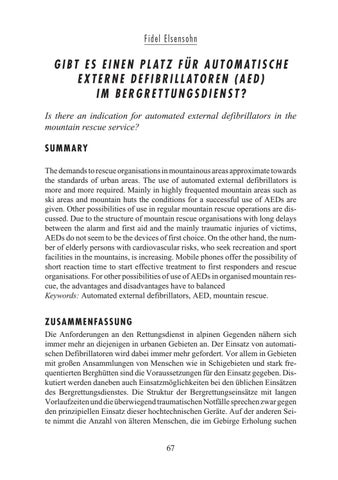Fidel Elsensohn
G I B T E S E I N E N P L AT Z F Ü R A U T O M AT I S C H E E X T E R N E D E F I B R I L L AT O R E N ( A E D ) IM BERGRETTUNGSDIENST? Is there an indication for automated external defibrillators in the mountain rescue service? S U M M A RY The demands to rescue organisations in mountainous areas approximate towards the standards of urban areas. The use of automated external defibrillators is more and more required. Mainly in highly frequented mountain areas such as ski areas and mountain huts the conditions for a successful use of AEDs are given. Other possibilities of use in regular mountain rescue operations are discussed. Due to the structure of mountain rescue organisations with long delays between the alarm and first aid and the mainly traumatic injuries of victims, AEDs do not seem to be the devices of first choice. On the other hand, the number of elderly persons with cardiovascular risks, who seek recreation and sport facilities in the mountains, is increasing. Mobile phones offer the possibility of short reaction time to start effective treatment to first responders and rescue organisations. For other possibilities of use of AEDs in organised mountain rescue, the advantages and disadvantages have to balanced Keywords: Automated external defibrillators, AED, mountain rescue.
Z U S A M M E N FA S S U N G Die Anforderungen an den Rettungsdienst in alpinen Gegenden nähern sich immer mehr an diejenigen in urbanen Gebieten an. Der Einsatz von automatischen Defibrillatoren wird dabei immer mehr gefordert. Vor allem in Gebieten mit großen Ansammlungen von Menschen wie in Schigebieten und stark frequentierten Berghütten sind die Voraussetzungen für den Einsatz gegeben. Diskutiert werden daneben auch Einsatzmöglichkeiten bei den üblichen Einsätzen des Bergrettungsdienstes. Die Struktur der Bergrettungseinsätze mit langen Vorlaufzeiten und die überwiegend traumatischen Notfälle sprechen zwar gegen den prinzipiellen Einsatz dieser hochtechnischen Geräte. Auf der anderen Seite nimmt die Anzahl von älteren Menschen, die im Gebirge Erholung suchen 67






